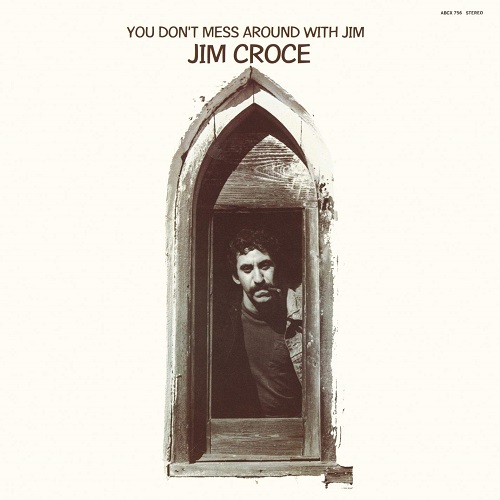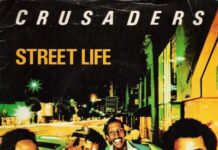Photo of A.J. and Jim Croce together courtesy of Joshua Black Wilkins and Paul Wilson
September 20, 1973 marked the day the music died a second time.
Jim Croce, the tender singer, songwriter, and artistic everyman, had just completed a performance and left Louisiana on a plane bound for an upcoming show in Texas. An hour after giving what would be his final concert, Croce and four others would perish in a crash. He left behind wife, Ingrid, infant son, Adrian James (A.J.), and an eternal question of “What could have been?”
He was 30 years old.
While Croce’s career until that point in time could be classified as “whirlwind” given his meteoric rise and creative output (three albums) in the span of a year-and-a-half, he was not an overnight sensation by any means. Over more than a decade, Croce paid his dues in everything from the halls of Villanova University in Pennsylvania, to folk clubs with his wife, to free moments when not spent toiling away at blue collar day jobs. His blood, sweat, and tears would all be documented in the discography he put forth.
“My father, he had not been able to be a professional musician — it was just not affordable,” A.J. Croce, himself a musician, tells me. “He couldn’t pay his bills playing music until the last 18 months of his life.”
While his physical look of a handlebar mustache, jeans, work boots, T-shirts, and smoldering cigars embodied someone you could share a beer with (or just as easily brawl with), Jim Croce’s voice would prove to be one of the more unique of the early 1970s, right as the singer-songwriter chrysalis fully bloomed into an artform-dominating butterfly. His accessible, empathetic tone would send songs like “Operator (That’s Not The Way It Feels),” “Time in a Bottle,” and “I Got A Name” up the Billboard Hot 100. At the same time, his penchant for penning a wide-ranging cast of characters would introduce listeners to folks like “Rapid Roy” the Stock Car Boy and (“Bad, Bad”) Leroy Brown.
Per A.J., who has resumed touring with his Croce Plays Croce concerts, dad Jim wasn’t shy about making sure his musical influences popped up as often as possible in his songwriting.

“He grew up in Philadelphia listening to a lot of R&B. Before the real folk movement, he was a huge fan of Sam Cooke; of obviously Leiber & Stoller’s writing, which you can hear all through his character songs,” he explains. “Of course, a little bit later on with different types of folk music…Obviously, you can hear the Jimmy Reed influences but you also hear the finger-style influences of guys like Reverend Gary Davis and Mississippi John Hurt, folks like that.”
In 1972 and 1973, Croce released two solo albums on the ABC label — You Don’t Mess Around With Jim and Life And Times. His final one, I Got A Name (featuring one of the best title tracks ever written), would be released posthumously before the end of 1973. Combined they encompass a one-of-a-kind listening experience that lasts just 90 total minutes. The first album turns 50 in April 2022 and even all these decades later it still reflects an artist chock full of both humility and bravado just trying to give it all he’s got in the hopes somebody out there is listening.
“First albums for a lot of artists are the chance to pick and choose the best that they’ve written in all of the time they’ve practiced and waited to get this opportunity. In my father’s case, it was a little bit different,” A.J. says. “While some of the songs may have been sort of started in the 60s or the ideas of them were started in the 60s, most everything here was written within a year of this album. By the time he wrote this he had already written most of the next record and a couple of things that ended up on the third album. So it was an incredibly creative period for him.
“One of the unique things about (You Don’t Mess Around With Jim) and being able to have listened to a lot of his recordings over the years — everything from covers to the music that he wrote and recorded with my mother before that — is that up until he wrote ‘Time In A Bottle,’ which was sort of the epiphany in a way, you really saw his influences worn on his sleeve,” he adds.
By the time this album is released, Croce is nearly close to calling it quits. Barely eking out a living playing and recording, Croce spends his days as everything from a teacher to a truck driver to a construction worker to support his family. Yet he never stops composing, plunking down idea after idea on homemade cassette tapes. The minimalism conveyed on these tapes would carry over to his formal recorded output.
“He was really ready for this music to be out there and he was ready to record it. It was kind of a perfect storm. He definitely felt that that this was his last chance,” A.J. says. “I was born, he had gone to college, he had gotten a master’s degree and taken all of these odd jobs…in the pursuit of being able to play music. I think he came close with the album that he and my mother recorded (Jim & Ingrid Croce) but that was very different because it was a duo. (You Don’t Mess Around With Jim) was really his first album and it’s a pretty amazing first release. I can’t think of too many other first albums by an artist that is so completely solid all the way through.”
Like contemporaries James Taylor and Joni Mitchell, Croce’s talents lie in his ability to capture the human condition and the elements that make all of us tick — love, battles, loneliness, and ebullience included. With a canvas of human emotions before him, he paints scenes with his soft plucking and warm voice that we can relate to and emulate, even if we aren’t physically in them. You Don’t Mess Around With Jim sets this trend in motion. “Time In A Bottle,” with its baroque musicality and heartfelt, romantic message of longing would eventually reach Number One after Croce’s death. The album’s title track, with its “boom-chak” chopping guitar rhythm, depicts a tough guy you may not like but you’re damn sure in awe of — even when he meets his demise at song’s end.
“I sort of separate the songs into two categories as a songwriter and musician,” A.J. points out. “You have these kind of R&B influenced character songs and then you have these very personal sort of … more folk-derived singer-songwriter tunes like ‘Time In A Bottle’ or ‘Operator.’ They somehow fit together on an album.
“The main place it comes from is observation and being empathetic. I think the other maybe more obvious place is that (Jim) had a degree in psychology. He understood the way that we think to some degree, the things that are important to us. I don’t think that was used in any sort of manipulative way in any sort of fashion at all. I think he was very sincere,” he adds.
Another Top 20 hit on the album, “Operator (That’s Not The Way It Feels)” tells the tale of a jilted lover trying to reach his significant other who has taken up with his “best old ex-friend Ray” before reaching a crucial epiphany that he can “overcome the blow” and actually move on. Croce successfully manages to convey three simultaneous narrative storylines (the caller, the operator, and the new couple) in the span of a four-minute single. We feel for Croce’s characters and wait with bated breath for a hopeful resolution.

“The story really started around 1964, 1965 when he was stationed [in the Army National Guard] at Fort Dix in New Jersey and waiting to use the phone and the phone booth had no door on it, which is like the perfect place for a budding songwriter to be able to observe and listen,” A.J. notes. “He heard all of these conversations of people breaking up and the struggles of being away from the people you love or thought you loved.”
Other album standouts include “Tomorrow’s Gonna Be A Brighter Day” and “Box #10.” While the latter tells a unique tale of a person down on his luck without a cent to his name who appeals to his parents to send him the money to get by, the former reflects a protagonist who knows he’s sacrificed the things most important for him to get a leg up in the world — not unlike Croce himself. Another track like “New York’s Not My Home” recalls Simon and Garfunkel’s “The Boxer,” as a pressure-riddled protagonist finds himself battered by his surroundings and yearns for a way out.
“‘Tomorrow’s Gonna Be a Brighter Day,’ I think, is one of his best songs that never sort of connected as well as ‘Box #10,’” A.J. says. “(‘Tomorrow’s Gonna Be a Brighter Day’) was semi-autobiographical. He wasn’t touring yet. When these songs were written, he had a day job. It wasn’t until this album got released that he really started touring and then it was a whirlwind of really 18 months.”
The success of Croce’s album would transfer over to his next two. Eschewing top-heavy production, Croce would rely on simple acoustic chords, basic bass and drums, and occasional strings to get his creative points across. Pretentiousness would never be a quality that defined him. Complementing Croce in the studio and live was musician Maury Muehliesen, who would also tragically die in the same 1973 plane crash.
“The thing about the way they played together was very unique,” A.J. says. “Maury had not played guitar for very long when they started performing together. He was in his early twenties and he had been a classical piano player and switched to guitar at 18 or 19. You can really hear how he applied that classical Bach counterpoint to what my dad was playing, especially on the more sort of classical or folk influenced songs. Even on things like ‘Operator,’ which is a more modern progression, you still hear this counterpoint and even though you know one person can’t play both parts, there’s something about it that really does feel like it’s just one unit.”
Croce was also the type to not let fame alter the way he saw the world. On the back of the You Don’t Mess Around with Jim album cover, he is wearing a blue Caterpillar (CAT) denim jacket.
“He never felt famous. He never felt successful. I think he was really surprised that anyone knew who he was or recognized him,” A.J. reveals. “He was a really humble person and while I think he had confidence in what he did and certainly had confidence on stage, I think he was a little bit uncomfortable without having a guitar between him and people he didn’t know.”
Croce’s fame would keep him consistently out on the road but before his death he contemplated getting out of the music business for good, devoting himself more to being home and with his family — ultimately fulfilling promises he outlined in his hit songs.
“He wrote this letter right before he passed away to all of his closest friends — I don’t know if you would say it was as much an apology as a recognition of what was happening in his life and the intent to sort of become grounded again,” A.J. says.
And then came September 20, 1973…
Still, Croce’s legacy has only gotten stronger over the years. Artists as diverse as Dolly Parton and Frank Sinatra have covered his songs. Rock surf group The Ventures even devoted an entire album of instrumentals to Croce’s music (which warrants its own listen!). You Don’t Mess Around With Jim is a strong testament to not only the talents of a musical trailblazer but also someone whose universality must be cemented for the ages.
“One of the trickiest things as a songwriter to do is to write something that is universal; that’s not a metaphor that can be sort of interpreted in a million different ways by a million different people but a story that is, at its core, universal,” A.J. explains. “The songs themselves are so timeless that I think every generation since then has been turned on to it.”

***
Share your feedback and suggestions for future columns with Ira at vinylconfessions84@gmail.com. Ira’s new book, “Hello, Honey, It’s Me”: The Story of Harry Chapin, is available for purchase here.




















